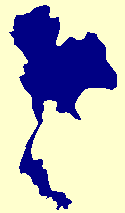
Flora of Thailand
Euphorbiaceae

 |
|
 |
K. Phattarahirankanok & P.C. van Welzen
Goto on this page:
Gagnep., Bull. Soc. Bot. France 71: 873. 1924; in Lecomte, Fl. Indo-Chine 5: 470. 1926; Pax & K.Hoffm. in Engl. & Harms, Nat. Pflanzenfam. ed. 2, 19c: 155. 1931; Airy Shaw, Kew Bull. 28: 122. 1969; Kew Bull. 26: 312. 1972; G.L.Webster, Ann. Missouri Bot. Gard. 81: 106. 1994; Radcl.-Sm., Gen. Euphorbiacearum: 298. 2001; Phattar. & Welzen in Welzen & Chayam., Fl. Thailand 8, 2: 465. 2007; G.L.Webster in Kubitzki, Fam. Gen. Vasc. Pl. 11: 175. 2014.
Shrubs, dioecious, deciduous, leaves appear at start of flowering season. Indumentum simple, mainly absent. Stipules minute, with a basal gland, caducous. Leaves alternate, simple, petiolate; axillary buds stipule-like; blade with an entire margin, lower surface with many glandular scales, triplinerved. Inflorescences leaf-opposed to terminal, staminate ones thyrsiform, pistillate ones pseudo-racemose; bracts and bracteoles small, linear. Flowers pedicellate; sepals imbricate; petals glandular at the apex; disc annular to cupular. Staminate flowers: pedicel with (sub)basal abscission zone; sepals 5; petals 5, apex with 1-3 glands; disc around and among stamens; stamens 13-15, filaments free, anthers dorsifixed, reniform, 2-thecate, introrse, connective with apical gland; pistillode absent or small, hairy. Pistillate flowers: sepals 5 or 6, not accrescent; petals absent to 2 or 3, apex with 5 glands; ovary 3-locular, 1 ovule per locule; style absent, stigmas apically bifid. Fruits 3-cornered, septicidally and loculicidally dehiscent; columella persistent, apically widened. Seeds subglobose, smooth, ecarunculate?.
A monotypic genus in S.E. Asia main land. Classification: Subfamily Crotonoideae, tribe Codiaeae.
Pantadenia adenanthera Gagnep., Bull. Soc. Bot. France 71: 873. 1924; in Lecomte, Fl. Indo-Chine 5: 470. 1926; Airy Shaw, Kew Bull. 23: 122. 1969, Kew Bull. 26: 312. 1972; P.H.Hô, Câyco Viêtnam 2, 1: 336. 1992; Phattar. & Welzen in Welzen & Chayam., Fl. Thailand 8, 2: 466, Fig. 51, Plate XXIV: 3. 2007.
Shrubs up to 2 m high, root tuberous; bark thin, light brown. Stipules narrowly triangular, 1.5-2 by c. 0.4 mm. Leaves: petiole 4-15 mm long; blade ovate, 7.5-17.5 by 3.7-8.5 cm, length/width ratio c. 2, base obtuse to emarginate, apex acuminate to cuspidate, upper surface glabrous, lower surface with red (or white) glandular scales and slightly hairy on midrib and basal nerves, nerves 6 or 7 pairs. Staminate nflorescences up to 5.5 cm long, light green; bracts ovate, with caudate apex, c. 1 by 0.3-0.5 mm, apically usually an inflexed gland. Staminate flowers 4.5-5 mm in diameter; pedicel up to 2 mm long; sepals ovate, 2.5-2.8 by 1.5-2.2 mm, pale light green to cream; petals elliptic, 1.2-1.5 by 0.4-0.7 mm, cream; disc yellow; stamens: filaments 1.7-2.2 mm long, very pale light green, anthers c. 0.7 by 0.4 mm. Pistillate inflorescences up to 3 cm long; bracts narrowly ovate, c. 1.8 by 0.8 mm, margins inrolled. Pistillate flowers c. 7.5 mm in diameter; pedicel above abscission zone 2-2.2 mm long; sepals ovate, sepals 3.5-4 by 2-2.2 mm; petals1.2-1.5 by 0.4-0.7 mm; ovary c. 1.2 by 2 mm, pale light green, densely hairy with bulbous based hairs, stigmas c. 3 mm long, upper 1.5-2 mm bifid, white. Fruit 5-6 by 6-8 mm; calyx persistent. Seed c. 4 mm in diameter.
T h a i l a n d.— CENTRAL: Phra Nakhon Si Ayutthaya (Menam Sak), Saraburi (Pa Sak River, Khao Yai National Park); SOUTH-EASTERN: Chachoengsao.
D i s t r i b u t i o n.— Laos, Cambodia (type), Vietnam.
E c o l o g y.— Scattered to common in mixed deciduous forest, in open fire-damaged, degraded areas; soil sandy, bedrock: rhyolite, sandstone or granite. 20-125 m. Flowering: March-May, October; fruiting: June.
U s e s.— Roots used medicinally in Cambodia.